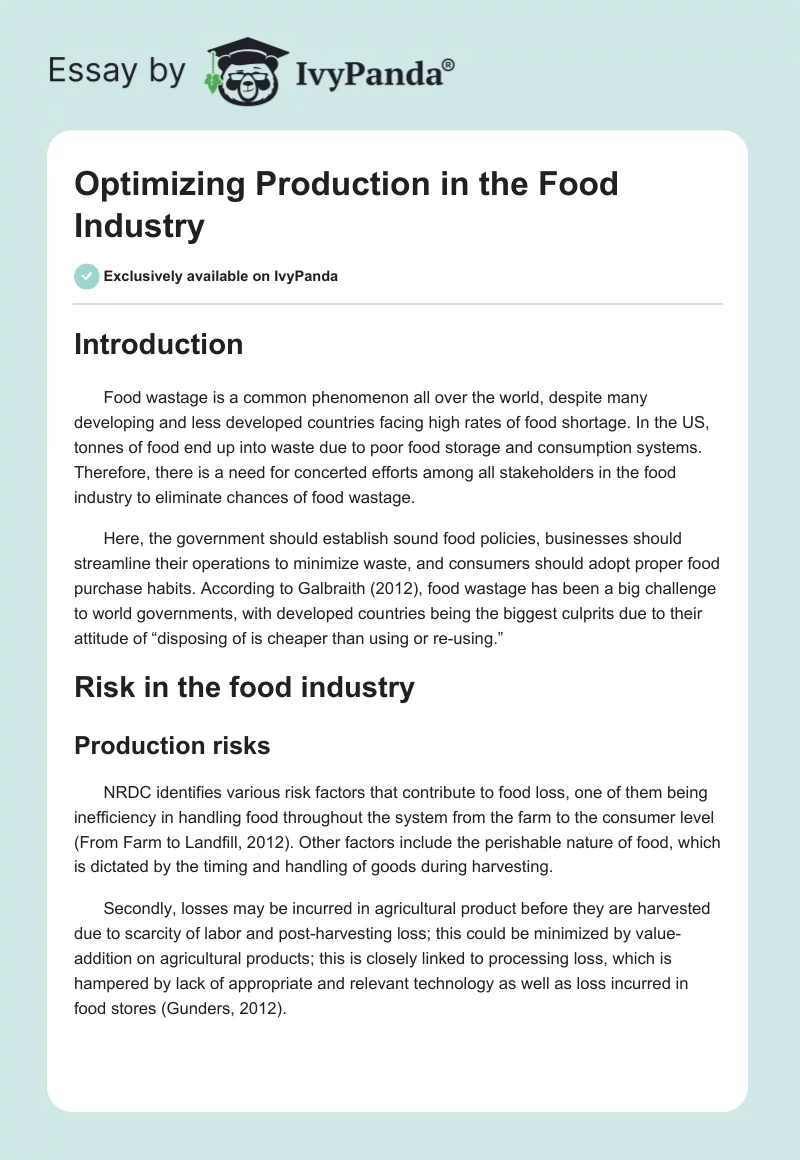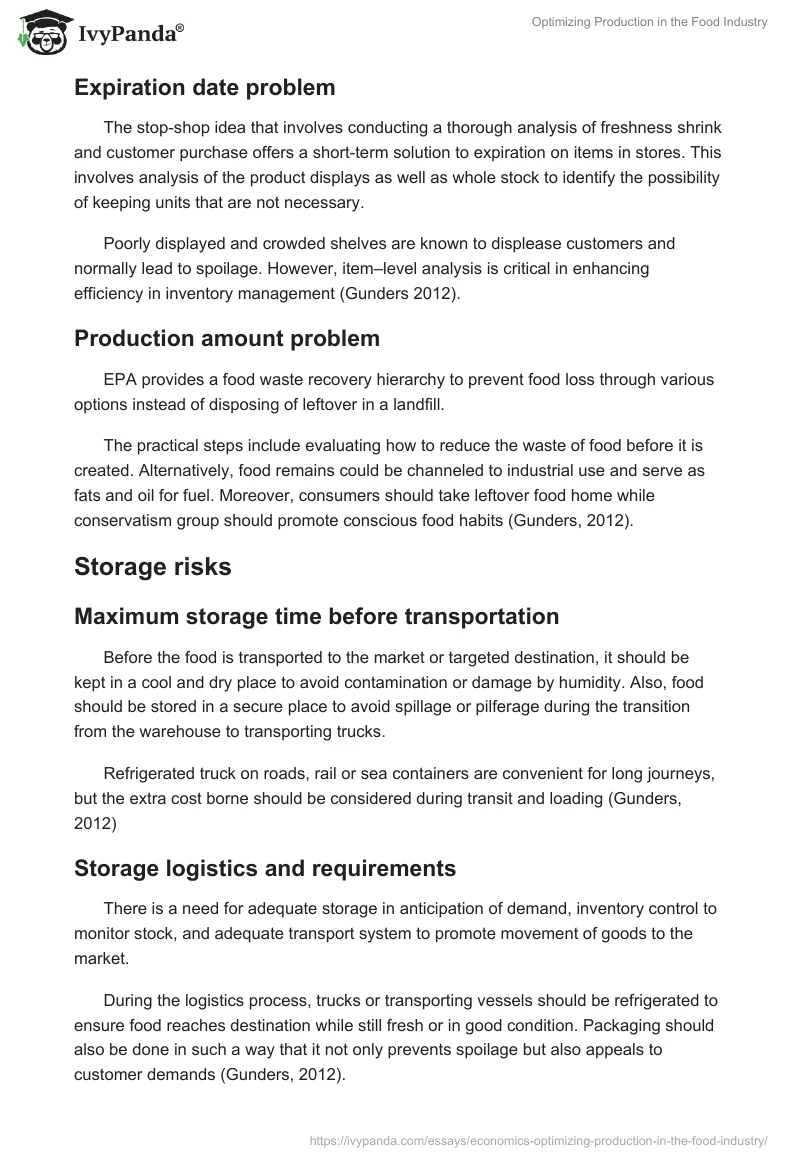Introduction
Food wastage is a common phenomenon all over the world, despite many developing and less developed countries facing high rates of food shortage. In the US, tonnes of food end up into waste due to poor food storage and consumption systems. Therefore, there is a need for concerted efforts among all stakeholders in the food industry to eliminate chances of food wastage.
Here, the government should establish sound food policies, businesses should streamline their operations to minimize waste, and consumers should adopt proper food purchase habits. According to Galbraith (2012), food wastage has been a big challenge to world governments, with developed countries being the biggest culprits due to their attitude of “disposing of is cheaper than using or re-using.”
Risk in the food industry
Production risks
NRDC identifies various risk factors that contribute to food loss, one of them being inefficiency in handling food throughout the system from the farm to the consumer level (From Farm to Landfill, 2012). Other factors include the perishable nature of food, which is dictated by the timing and handling of goods during harvesting.
Secondly, losses may be incurred in agricultural product before they are harvested due to scarcity of labor and post-harvesting loss; this could be minimized by value-addition on agricultural products; this is closely linked to processing loss, which is hampered by lack of appropriate and relevant technology as well as loss incurred in food stores (Gunders, 2012).
Expiration date problem
The stop-shop idea that involves conducting a thorough analysis of freshness shrink and customer purchase offers a short-term solution to expiration on items in stores. This involves analysis of the product displays as well as whole stock to identify the possibility of keeping units that are not necessary.
Poorly displayed and crowded shelves are known to displease customers and normally lead to spoilage. However, item–level analysis is critical in enhancing efficiency in inventory management (Gunders 2012).
Production amount problem
EPA provides a food waste recovery hierarchy to prevent food loss through various options instead of disposing of leftover in a landfill.
The practical steps include evaluating how to reduce the waste of food before it is created. Alternatively, food remains could be channeled to industrial use and serve as fats and oil for fuel. Moreover, consumers should take leftover food home while conservatism group should promote conscious food habits (Gunders, 2012).
Storage risks
Maximum storage time before transportation
Before the food is transported to the market or targeted destination, it should be kept in a cool and dry place to avoid contamination or damage by humidity. Also, food should be stored in a secure place to avoid spillage or pilferage during the transition from the warehouse to transporting trucks.
Refrigerated truck on roads, rail or sea containers are convenient for long journeys, but the extra cost borne should be considered during transit and loading (Gunders, 2012)
Storage logistics and requirements
There is a need for adequate storage in anticipation of demand, inventory control to monitor stock, and adequate transport system to promote movement of goods to the market.
During the logistics process, trucks or transporting vessels should be refrigerated to ensure food reaches destination while still fresh or in good condition. Packaging should also be done in such a way that it not only prevents spoilage but also appeals to customer demands (Gunders, 2012).
Return Problems
There are possibilities of returns, which the firm must address to avoid losses. Vendors may supply food that may be spoiled either from their stores or during transportation.
Food may be returned to stores or food banks if they are rejected during shipment or by buyers due to some reasons, and in case new buyers are not found in time, most perishable food would go to waste (Gunders, 2012). However, the use of technology, especially online trading, to look for the market of returned food would be important in reducing waste (Gunders, 2012).
Optimizing production
Quality control during production
Moreno (2008) highlights the best possible performance to be ‘optimal operations’ where waste is minimized through the implementation of sound decisions and solutions, as well as optimization of technological solutions. Generally, quality can only be ensured before the completion of the actual manufacturing process.
This would involve ensuring the right raw materials are used and ensuring the process is effective based on equipment used and competence of personnel. Moreover, an inspection of finished products is important to ensure that only those products that pass the quality test are sent to stores and market (Adu-Amankwa, 1999).
Managing production Risks
There are various measures of managing production risks, among them being diversification, which helps in spreading risks to different areas. Also, there is a need to manage excess capacity by monitoring the demand. Agriculture farmers can enter into a lease arrangement to optimize capital and minimize waste.
Moreover, contemporary production practices call for insurance services in order to provide safety nets or cushion in case of loss or damage. Finally, everyone involved is supposed to access the latest information on market trends in order to ensure production is done in response to market demand.
Extending expiration versus maintaining quality
Most foods are discarded due to the expiry of “sell by date” although some of the dates are not accurate. Even after expiry of the date, food is still consumable but has a limited shelf life and may not be sold directly in retail due to legal implications. Therefore, it is important to continue consuming such food for some time, since the expiry date is only intended to aid in the stocking of fresh goods (Gunders, 2012).
Finally, there should be coordination between various teams involved in the production who should ensure that specifications are detailed including date of expiry of raw materials, use of preservatives and expected shelf life of finished products (Adu-Amankwa, 1999).
Studying the market requirements
According to Moreno (2008), production risks may be reduced by taking into consideration the market demand including the amount to be delivered and the quality demanded by consumers. It is also important to analyze competitors as well as prevailing demand in order to formulate strategies that ensure goods reach the market when they are needed.
Applying Historical Reasoning
An integrated model of reasoned action is one means of managing waste by testing the behavior of households. This theory considers that people’s conduct is determined by the intention of carrying out a certain behavior. Three factors would relate to intent to achieve the right action, which includes personal attitude towards the output, the perceived social norms, and the perceived behavioral control over the action.
The objective is to identify public attitude as regards to food wastage habits and demonstrate whether a relationship exists between the recommended measures to curb food loss and the intention to reinforce the right practice (Gunders, 2012).
Managing storing problem
Mutable storage facilities in location vs. central storage
Emerging issues to draw the line in correcting food waste as a result of storage during FAO 2011 forum included the adoption of post-harvesting management solutions, which would cut middlemen and allow farmers to be connected to direct markets. Services like warehousing, collateral management, quality testing, agricultural insurance, and bulk procurement are considered necessary.
Food processing is considered key to preventing loss during transit. Moreover, whether storage is done locally or in community stores, there is a need to use pesticides to prevent losses due to damage or spoilage (FAO, 2014).
Controlled environment storage
One way to avoid wastage problem is to control the supply and consumption of food through controlled environment storage. This would involve allocating the role of food supply to one accountable person or department who will supply food based on consumption requirement but not just on request (FAO, 2014).
Transport optimization
Merging transportation routes
Several factors come into play that helps in optimizing transport needs; these include considering limiting capacity to the need for goods, designing convenient packaging, and need for close supervision during loading and unloading.
In addition, there is a need for checking on extreme weather conditions like high temperatures and rain. Importantly, packing goods should be done in such a way that it promotes the circulation of air as well as easier loading, especially when several trips are to be made (Gunders, 2012).
Reducing waste through alternative and fast transportation
Most perishable goods need to reach consumers as soon as possible before getting spoilt. As a result, there is a need for efficient and fast transportation from farms to the market.
For short distances, trucks or rail services may be used, but for long distances, air cargo services are the most appropriate mode of transport. Moreover, improving infrastructure such as roads would be important in ensuring food moves faster from farms to markets (Galbraith, 2012)
Recommendation
Given the grim statistics of loads of tones of food that end up in waste and the reality that there is dire need to address the imbalance in food distribution across the world to end hunger, it is important to consider the following practical steps. First, there is a need to encourage responsible eating in food outlets by serving small portions to curb food wastage.
Secondly, people should adopt a plan for the food need requirements to prevent excess wastage that results from unwanted or unconsumed food. Thirdly, donating food to charities could help feed the deserving people in society; here, philanthropy should be encouraged to help channel excess food from dining tables or restaurants.
Fourth, composting or recycling food that is not needed is a good alternative, since it could be channeled to other productive purposes such as manufacturing of manure (Navarro, 2013). Fifth, refrigeration of perishables, especially fresh produce during abundant seasons, will help prevent losses. Sixth, conservative groups should play a role in informing people about ethical food habits and conscious eating (FAO, 2014).
Conclusion
Eradicating extreme hunger and poverty is important in realizing the millennium development goals. In developing counties, millions of people experience extreme pangs of hunger and starvation.
The realization that tones of food end in landfills through irresponsible habits should drive people to engage in rational behavior about consumption, and storage of food. Also, correct societal perception would help in instilling the right ethical approach to wastage of food in homes and industries. Nevertheless, it is important to be conscious of eating habits right from homes to public places.
References
Adu-Amankwa, P. (1999). Quality and Process Control in the Food Industry. Web.
FAO. (2014). Food waste harms climate, water, land and biodiversity – new FAO report. Web.
From Farm to Landfill. (2012). New York Times. Web.
Galbraith, K. (2012). The Battle against Food Waste. New York Times. Web.
Gunders, D. (2012). How America is losing up to 40 percent of its food from Farm to Fork Land fill. Web.
Moreno, C. (2008). Optimization in Production Operations Optimal “Lean Operations” in Manufacturing. Web.
Navarro, M. (2013). Plan to Separate Food Waste Will Expand. New York Times. Web.


